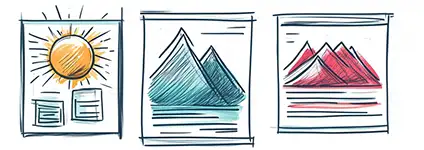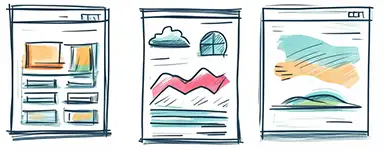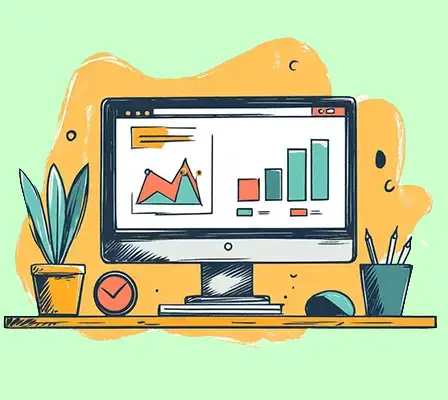Optimising website images for SEO involves a combination of techniques to enhance accessibility, improve user experience, and boost search engine rankings. Here's a comprehensive outline:

1. Use Descriptive File Names
- Rename image files with descriptive, keyword-rich names before uploading. Avoid generic names like IMG1234.jpg.
- Example: Instead of IMG1234.jpg, use website-image-optimisation.jpg.
2. Optimise Alt Text for Accessibility and SEO
- Write clear, concise alt text that describes the image accurately for visually impaired users.
- Include relevant keywords naturally, but don’t keyword-stuff.
- Example: "A hand drawn website image of an artists palette and brush."
3. Add a Title Attribute
- Use the title attribute for supplementary information, often to provide context or encourage interaction.
- Example: "Learn about Image Optimisation."
4. Select the Right File Format
Use appropriate file formats:
- JPEG: Best for photos with complex colours.
- PNG: Best for images requiring transparency.
- WebP: Offers a good balance of quality and compression.
- SVG: Ideal for logos and icons.
5. Compress Images for Faster Load Times
- Use compression tools like TinyPNG, ShortPixel, or ImageOptim to reduce file size without sacrificing quality.
- Aim for image sizes under 100 KB for optimal performance.

6. Implement Responsive Images
- Use HTML’s <picture> element or the srcset attribute to serve appropriately sized images for different screen resolutions and devices.
Example:
<picture>
<source srcset="image-large.jpg" media="(min-width: 800px)">
<source srcset="image-small.jpg" media="(max-width: 799px)">
<img src="image-default.jpg" alt="An artists palette and brush.">
</picture>
7. Leverage Structured Data
- Add structured data to images, especially for logos, products, or key visuals.
- Use JSON-LD to mark up images with schema types like ImageObject.
Example:
{
"@context": "https://schema.org/",
"@type": "ImageObject",
"contentUrl": "https://www.example.com/image-default.jpg",
"description": "An artists palette and brush.",
"name": "Website Image Optimisation"
} 
8. Optimise Captions and Surrounding Text
- Use captions to add context and engage readers.
- Ensure the text around the image reinforces the image’s topic and includes relevant keywords.
9. Use Image Sitemaps
- Create an image sitemap to help search engines discover all images on your site.
- Include details like image location, title, and caption.
Example
<url>
<loc>https://www.example.com/web-design-tips</loc>
<image:image>
<image:loc>https://www.example.com/images/image-optimisation.jpg</image:loc>
<image:title>Website Image optimisation</image:title>
<image:caption>Our Web studio offers image optimisation services</image:caption>
</image:image>
</url> 
10. Enable Lazy Loading
- Use lazy loading to defer the loading of images until they’re visible in the user’s viewport.
- Add loading="lazy" to image tags:
<img src="image-name.jpg" alt="sketch of brushes" loading="lazy">11. Ensure Mobile-Friendliness
- Test images for mobile responsiveness using tools like Google’s Mobile-Friendly Test.
- Prioritise fast-loading, optimised visuals for mobile users.
12. Verify Page Speed with Tools
- Use tools like Google PageSpeed Insights or GTmetrix to analyse image performance and resolve issues.
Best Practice Summary
- Alt Text: For accessibility and light SEO focus.
- Title Attribute: For context and engagement.
- File Name: Descriptive and keyword-optimised.
- Compression: Reduced file size for faster loading.
- Responsive Images: Adapts to user devices.
- Structured Data: Adds metadata for search engines.
- Sitemaps: Helps image indexing.
When combined, these practices ensure your images contribute to both user experience and SEO performance.

THAT'S A LOT OF WORK!!!!
You're absolutely right - it can feel like a lot of work! But optimising images is about striking a balance between effort and payoff. Let's break it down into manageable steps and why it's worth the effort:
Why Image Optimisation Matters
- Faster Load Times: A faster website improves user experience, reduces bounce rates, and can boost SEO rankings.
- Better Rankings: Search engines can’t "see" images, but they can read alt text, filenames, and structured data. These elements help search engines understand your content.
- More Clicks: Properly optimised images enhance the visual appeal of your site, making it more engaging for visitors.
- Accessibility: Alt text ensures visually impaired users can still access the content.
Keep It Simple: A Practical Workflow
You don’t have to do everything for every image. Here's a streamlined approach:
- Rename the File Before Upload: Use a descriptive name like web-design-milton-keynes.jpg.
- Add Alt Text: Describe the image accurately while sneaking in a keyword if possible (e.g., “A web designer working at the computer.”).
- Compress the File: Use a tool like TinyPNG. It takes seconds and ensures fast loading.
- Use Lazy Loading: Just add loading="lazy" to your image tag—modern browsers handle the rest.
When to Go the Extra Mile
For key pages like your homepage, service pages, or product pages, it's worth:
- Adding structured data for important images.
- Creating an image sitemap.
- Being meticulous about captions and surrounding text.
For blog posts and secondary pages, stick to the basics: filenames, alt text, compression, and lazy loading.
Why the Effort is Worth It
Think of it this way: Every optimised image is a small step toward:
- Better visibility in search engines.
- Improved site performance for all users.
- Stronger conversions as visitors stay longer and engage with your content.
It's about the cumulative effect. A well-optimised site doesn't just look good; it performs well too.

- What is website image optimisation?
Website image optimisation is the process of reducing image file sizes, enhancing their quality, and using SEO-friendly practices to improve site speed, user experience, and search engine visibility. - How does optimising images improve SEO?
Optimised images improve page load speed, which is a ranking factor for search engines. They also help search engines understand your content better through alt text and structured data. - What tools can I use for image optimisation?
Popular tools include TinyPNG, ImageOptim, Adobe Photoshop, and WordPress plugins like Smush or ShortPixel. These tools compress images while maintaining quality. - What is the best format for website images?
Use JPEG for photos, PNG for images needing transparency, and WebP for modern web optimisation as it offers superior compression without quality loss. - Should I add alt text to all my images?
Yes, alt text is essential for accessibility and SEO. It helps visually impaired users and enables search engines to understand the image content, improving your site’s ranking potential. Dont forget to use the title too.

Author
Technical Director
With over 20 years of experience in building and promoting websites, Neil is a seasoned expert in digital marketing and SEO. Passionate about helping businesses grow through innovative web solutions, Neil has successfully built over 400 websites.

